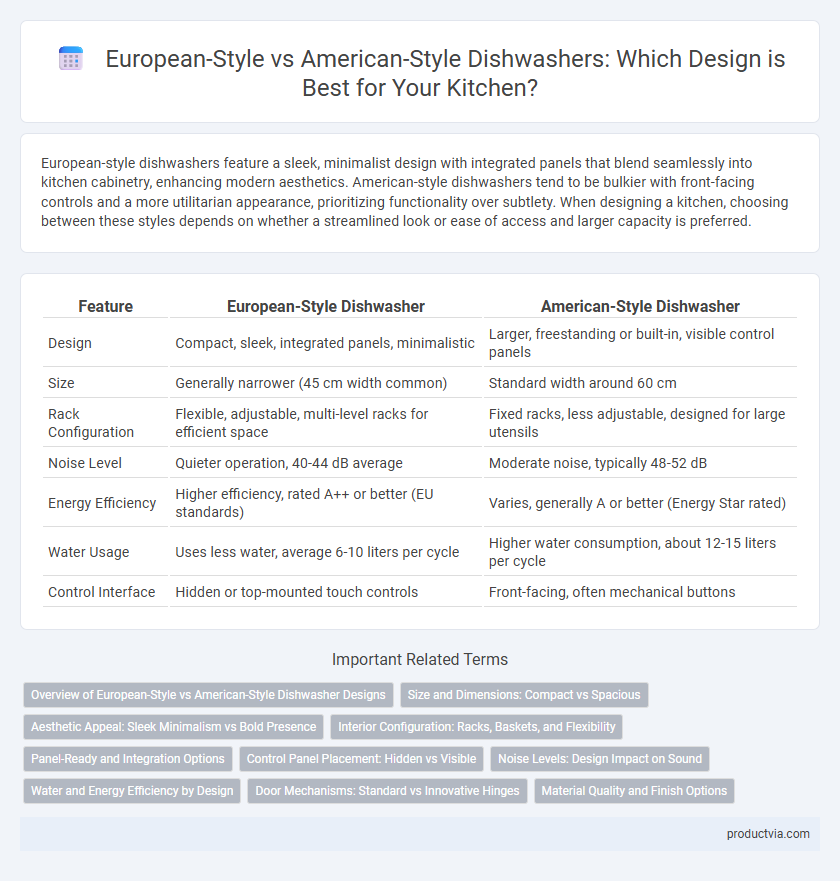European-style dishwashers feature a sleek, minimalist design with integrated panels that blend seamlessly into kitchen cabinetry, enhancing modern aesthetics. American-style dishwashers tend to be bulkier with front-facing controls and a more utilitarian appearance, prioritizing functionality over subtlety. When designing a kitchen, choosing between these styles depends on whether a streamlined look or ease of access and larger capacity is preferred.
Table of Comparison
| Feature | European-Style Dishwasher | American-Style Dishwasher |
|---|---|---|
| Design | Compact, sleek, integrated panels, minimalistic | Larger, freestanding or built-in, visible control panels |
| Size | Generally narrower (45 cm width common) | Standard width around 60 cm |
| Rack Configuration | Flexible, adjustable, multi-level racks for efficient space | Fixed racks, less adjustable, designed for large utensils |
| Noise Level | Quieter operation, 40-44 dB average | Moderate noise, typically 48-52 dB |
| Energy Efficiency | Higher efficiency, rated A++ or better (EU standards) | Varies, generally A or better (Energy Star rated) |
| Water Usage | Uses less water, average 6-10 liters per cycle | Higher water consumption, about 12-15 liters per cycle |
| Control Interface | Hidden or top-mounted touch controls | Front-facing, often mechanical buttons |
Overview of European-Style vs American-Style Dishwasher Designs
European-style dishwashers typically feature a sleek, built-in design with fully integrated control panels hidden on the top edge of the door, offering a seamless appearance that blends with cabinetry. American-style dishwashers often have visible front controls and a freestanding or semi-integrated design prioritizing ease of use and accessibility. Differences in size and capacity also exist, with European models generally smaller and more compact to suit narrower kitchens, compared to larger American models designed for higher volume cleaning.
Size and Dimensions: Compact vs Spacious
European-style dishwashers typically feature compact dimensions around 18 inches wide, designed to fit smaller kitchens and optimize space efficiency. American-style dishwashers often measure 24 inches in width, providing a more spacious interior suitable for larger dish loads. The size differences affect installation options and influence kitchen layout planning, with European models prioritizing compactness and American models emphasizing capacity.
Aesthetic Appeal: Sleek Minimalism vs Bold Presence
European-style dishwashers emphasize sleek minimalism with integrated panels that blend seamlessly into kitchen cabinetry, creating a streamlined and modern aesthetic. American-style dishwashers often feature bold presence with prominent control panels and visible brand logos, contributing to a strong visual statement. The choice between these designs influences overall kitchen aesthetics, balancing subtlety with distinctive character.
Interior Configuration: Racks, Baskets, and Flexibility
European-style dishwashers typically feature a more modular interior configuration with adjustable racks and multi-level baskets designed for enhanced flexibility, allowing users to customize space for varied dish sizes and shapes. These models often incorporate folding tines and removable cutlery trays, optimizing load capacity and accessibility. American-style dishwashers generally emphasize fixed rack layouts with larger baskets, aiming for straightforward loading of bulky items but offering less adaptability compared to their European counterparts.
Panel-Ready and Integration Options
European-style dishwashers typically feature a sleek, panel-ready design that allows seamless integration with cabinetry, enhancing kitchen aesthetics through customizable fronts that match existing decor. American-style dishwashers often emphasize standalone units with visible control panels and durable stainless steel exteriors designed for ease of use and maintenance. The panel-ready option in European models supports full kitchen integration, while American designs prioritize functional accessibility and user-friendly interfaces.
Control Panel Placement: Hidden vs Visible
European-style dishwashers typically feature a hidden control panel located on the top edge of the door, providing a sleek, minimalist exterior that blends seamlessly with kitchen cabinetry. American-style dishwashers commonly have a visible control panel on the front, offering easy access and straightforward operation but a less integrated appearance. This design choice impacts kitchen aesthetics and user interaction, with hidden controls favored for modern, streamlined designs and visible controls preferred for convenience.
Noise Levels: Design Impact on Sound
European-style dishwashers tend to have better sound insulation and quieter operation due to their integrated design and advanced noise-reducing technology, often producing noise levels as low as 38-44 decibels. American-style dishwashers, typically freestanding with standard insulation, generally emit higher noise levels around 50-60 decibels, impacting kitchen ambiance more noticeably. The design differences directly influence the effectiveness of soundproofing materials and vibration reduction, making European models preferable for quieter environments.
Water and Energy Efficiency by Design
European-style dishwashers typically feature compact, sleek designs optimized for smaller kitchens and use advanced sensor technology to reduce water consumption to as low as 7 liters per cycle, compared to American models that may use 10-15 liters per cycle. They prioritize energy efficiency with A++ to A+++ ratings under EU energy labeling, incorporating eco-friendly wash cycles and low-power standby modes. American-style dishwashers often emphasize larger capacity and robust cleaning performance but generally consume more water and energy due to less stringent efficiency standards.
Door Mechanisms: Standard vs Innovative Hinges
European-style dishwashers feature innovative hinge designs that allow the door to fully retract under the appliance, creating a seamless integration with kitchen cabinetry and saving space in tight kitchens. American-style dishwashers typically use standard drop-down doors that open outward, requiring additional clearance and often disrupting countertop or cabinetry alignment. The European innovative hinges enhance ergonomic access and modern kitchen aesthetics, while American standard hinges prioritize familiarity and simpler installation.
Material Quality and Finish Options
European-style dishwashers emphasize sleek, minimalist designs with high-quality stainless steel interiors and customizable panel-ready exteriors, offering superior durability and a seamless kitchen integration. American-style dishwashers often feature plastic tub interiors and standardized white or black finishes, prioritizing affordability and practicality over design flexibility. The premium materials and refined finishes of European models contribute to enhanced longevity and aesthetic appeal in modern kitchen settings.
European-style dishwasher vs American-style dishwasher for design Infographic

 productvia.com
productvia.com